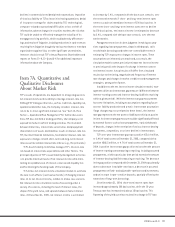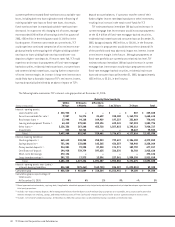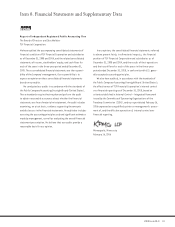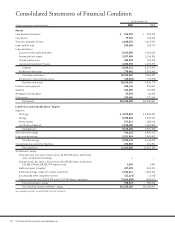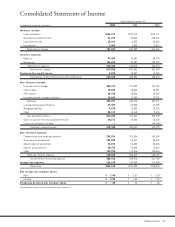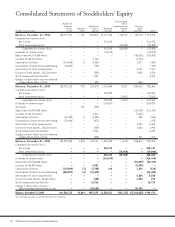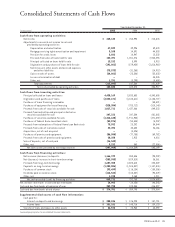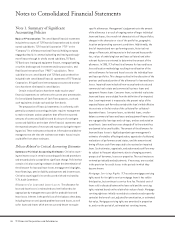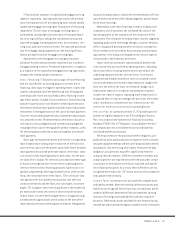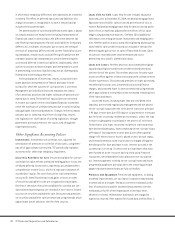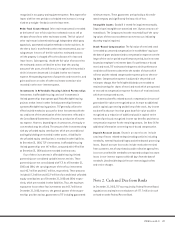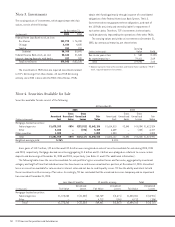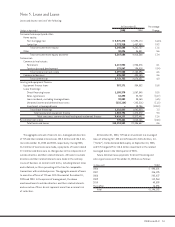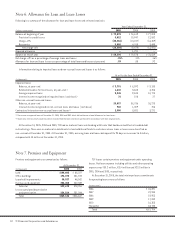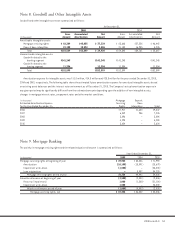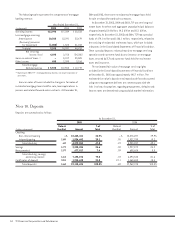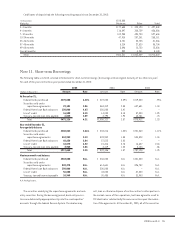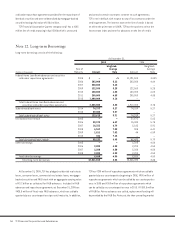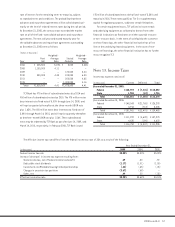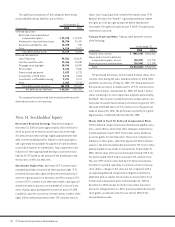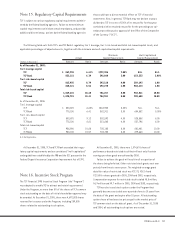TCF Bank 2005 Annual Report Download - page 69
Download and view the complete annual report
Please find page 69 of the 2005 TCF Bank annual report below. You can navigate through the pages in the report by either clicking on the pages listed below, or by using the keyword search tool below to find specific information within the annual report.
492005 Form 10-K
recognized in occupancy and equipment expense. Rent expense for
leases with free rent periods or scheduled rent increases is recog-
nized on a straight-line basis over the lease term.
Other Real Estate Owned Other real estate owned is recorded
at the lower of cost or fair value less estimated costs to sell at
the date of transfer to other real estate owned. The fair value of
other real estate is determined through independent third-party
appraisals, automated valuation methods or broker opinions. At
the time a loan is transferred to other real estate owned, any car-
rying amount in excess of the fair value less estimated costs to
sell the property is charged off to the allowance for loan and
lease losses. Subsequently, should the fair value of an asset less
the estimated costs to sell decline to less than the carrying
amount of the asset, the deficiency is recognized in the period in
which it becomes known and is included in other non-interest
expense. Net operating expenses of properties and recoveries, and
gains and losses on sales of other real estate owned are also
recorded in other non-interest expense.
Investments in Affordable Housing Limited Partnerships
Investments in affordable housing consist of investments in
limited partnerships that operate qualified affordable housing
projects or that invest in other limited partnerships formed to
operate affordable housing projects. TCF generally utilizes the
effective yield method to account for these investments with the
tax credits net of the amortization of the investment reflected in
the Consolidated Statements of Income as a reduction of income
tax expense. However, depending on circumstances, the equity or
cost methods may be utilized. The amount of the investment along
with any unfunded equity contributions which are unconditional
and legally binding are recorded in other assets. A liability for
the unfunded equity contributions is recorded in other liabilities.
At December 31, 2005, TCF’s investments in affordable housing
limited partnerships were $47 million, compared with $49 million
at December 31, 2004 and were recorded in other assets.
Four of these investments in affordable housing limited
partnerships are considered variable interest entities. These
partnerships are not consolidated with TCF. As of December 31,
2005 and 2004, the carrying amount of these four investments
was $43.7 million and $46.7 million, respectively. These amounts
included $2.3 million and $13.9 million of unconditional unfunded
equity contributions as of December 31, 2005 and 2004, respec-
tively, which are recorded in other liabilities. Thus, the maximum
exposure to loss on these four investments was $43.7 million at
December 31, 2005; however, the general partner of these part-
nerships provides various guarantees to TCF including guaranteed
minimum returns. These guarantees are backed by a AA credit-
rated company and significantly limit any risk of loss.
Intangible Assets Goodwill is tested for impairment annually.
Deposit base intangibles are amortized over 10 years on an accel-
erated basis. The Company reviews the recoverability of the carry-
ing values of these assets whenever an event occurs indicating
that they may be impaired.
Stock-Based Compensation The fair value of restricted stock
is recorded as unearned compensation in stockholders’ equity on
the date of grant and amortized to compensation expense over the
longer of the service period or performance period, but in no event
beyond an employee’s retirement date. For performance-based
restricted stock, TCF estimates the degree to which performance
conditions will be met to determine the number of shares which
will vest and the related compensation expense prior to the vest-
ing date. Compensation expense is adjusted in the period such
estimates change. Non-forfeitable dividends are recorded to
retained earnings for shares of restricted stock which are expected
to vest and to compensation expense for shares of restricted stock
which are not expected to vest.
Income tax benefits related to stock compensation in excess of
grant date fair value are recognized as an increase to additional
paid in capital upon vesting and delivery of the stock. Any income
tax benefits that are less than grant date fair value would be
recognized as a reduction of additional paid in capital to the
extent of previously recognized income tax benefits and then as
compensation expense for the remaining amount. See Note 16 for
additional information concerning stock-based compensation.
Deposit Account Losses Deposit account losses include
a variety of losses related to deposit taking activities including
overdrafts, external fraud and forgery and other deposit processing
losses. Deposit account losses also include restitution received
from customers, net of any related outside collection agency fees.
Losses on uncollectible overdrafts are reported as deposit account
losses in non-interest expense within 60 days from the date of
overdraft. Uncollectible deposit fees are reversed against fees
and service charges.
Note 2. Cash and Due from Banks
At December 31, 2005, TCF was required by Federal Reserve Board
regulations to maintain reserve balances of $77.7 million in cash
on hand or at the Federal Reserve Bank.


